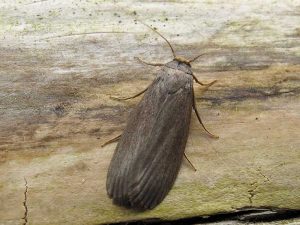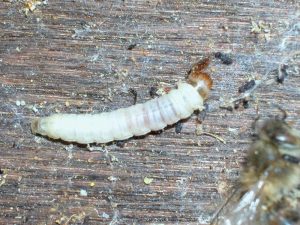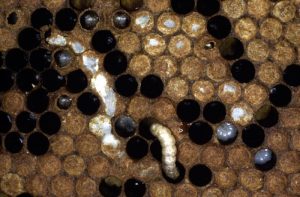There are currently two known species of wax moth that occupy and damage honey bee colonies. Each one has four stages of development: egg; larva; pupa; and adult. The greater wax moth, Galleria mellonella, is the more destructive and common pest whilst the lesser wax moth, Achroia grisella is both less prevalent and less destructive. Wax moth infestations are caused by

unhygienic management practices; leaving scraps of burr comb lying around the apiary and empty and exposed supers or brood boxes with drawn comb in will attract moths. When the equipment is left over a long period of time, this gives ample opportunity for infestations of wax moth to get out of control. Drawn comb can become damaged and eaten away, making in unworkable for colonies of honey bees.
Biology
Females oviposit eggs into crevasses and gaps within the hive where they remain out of reach of nursing bees. Once the larvae hatch, they immediately search for comb in which to feed. The thoracic legs are immediately visable and well developed and as the larva feeds and grows they develop, the abdominal legs become more prominent after around 3 days old. Speed of growth is directly dependent on temperature and food supply. Under ideal conditions the larval weight can double daily during the first 10 days.
A greater wax moth larva moults 7 times throughout its development. Most of the growth and size increase happens during the final 2 instars. Larval development lasts 6-7 weeks at 29° – 32° C and high humidity. As the greater wax moth larva matures, it will reach a length of around 20 mm and its body will turn grey in colour with a brown prothoracic shield having a broad band across it.
Mature greater wax mo

th larvae bore into wood and often make boat-shaped indentations in the hive body or frames. After finding a place in the hive to pupate, the larva begins spinning a silk thread cocoon, which they attach to the excavated indentations. The development stage of greater wax moths varies from 6 to 55 days, depending on factors such as temperature.
Adult moths reach a length of 15 mm long with a 31 mm average wingspan. The wings are grey in colour but the hind third of the wing, normally hidden, is bronze coloured.
Damage to colonies
Mature greater wax moth larvae bore into woodwork and often make boat-shaped indentations in brood boxes, supers, crownboards and frames. After finding a place to pupate, the larva begins spinning silk threads to make the cocoon, which can be seen attached to the excavated indentations. On close inspection, one will find large amounts of cocoons congregated in areas around the periphery of the bee nest.

Control
Are there other species of wax moth?
Further reading
Further information about the biology and identification features of all stages of wax moth can be found on the COLOSS website.
Adapted from BeeBase, National Bee Unit, Animal Health and Plant Agency (APHA) under the terms of the Open Government Licence (OGL). Crown Copyright.